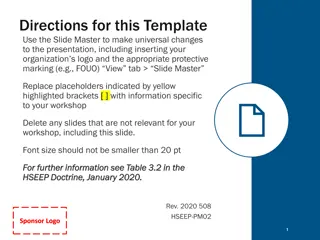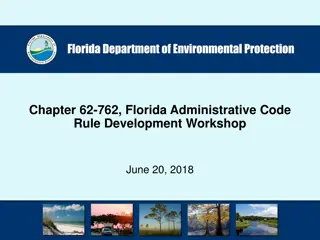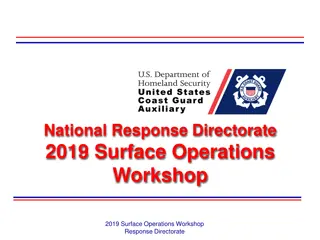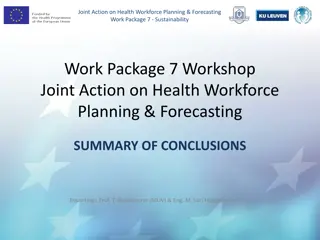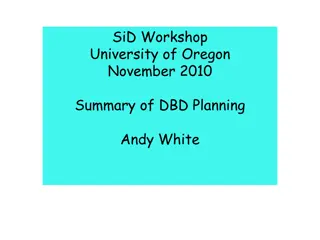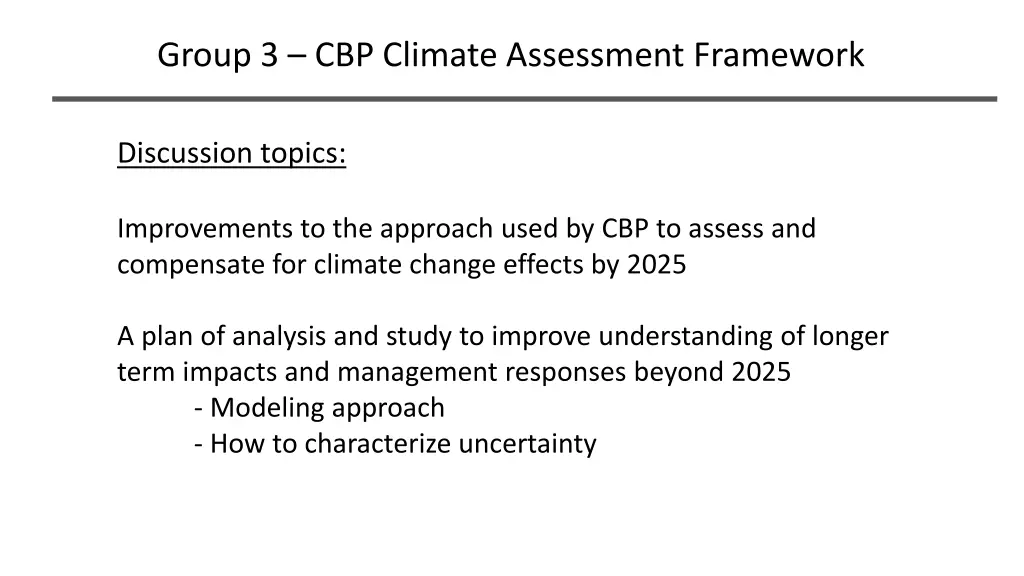
Enhancing CBP Climate Assessment Framework Discussion on Climate Change Effects & Management Strategies
Explore how Group 3 recommends improvements to assess and compensate for climate change effects by 2025 while planning for longer-term impacts. Suggestions include refining modeling approaches, characterizing uncertainty, and incorporating seasonal variability for better risk management.
Download Presentation

Please find below an Image/Link to download the presentation.
The content on the website is provided AS IS for your information and personal use only. It may not be sold, licensed, or shared on other websites without obtaining consent from the author. If you encounter any issues during the download, it is possible that the publisher has removed the file from their server.
You are allowed to download the files provided on this website for personal or commercial use, subject to the condition that they are used lawfully. All files are the property of their respective owners.
The content on the website is provided AS IS for your information and personal use only. It may not be sold, licensed, or shared on other websites without obtaining consent from the author.
E N D
Presentation Transcript
Group 3 CBP Climate Assessment Framework Discussion topics: Improvements to the approach used by CBP to assess and compensate for climate change effects by 2025 A plan of analysis and study to improve understanding of longer term impacts and management responses beyond 2025 - Modeling approach - How to characterize uncertainty
Group 3 - Participants Group 3 Members: Maria Herrmann* Tom Johnson* Don Boesch Rob Nicholas Chris Forest Victoria Coles Andrew Ross Jordan Fischbach Zoe Johnson Cross-Cutters: Mark Bennett Lee Currey Dave Montali James Davis-Martin Brian Benham
Group 3 General Recommendations Uncertainties associated with projecting climate change impacts should be clearly characterized, together with the recognition that climate change impacts will present an evolving, moving target throughout the coming century. The CBP response to CC should be framed as an iterative, risk management problem In addition to estimating climate change effects, CBP should also consider solutions, e.g., how best management practices (BMPs) could be adapted to mitigate effects
Group 3 Short Term (2025) Assessment As currently implemented, the delta method used to create future scenarios does not capture seasonal variability. The methods used to create climate change scenarios should be revised to incorporate seasonal variability An effort should be made to improve the representation of shoreline processes (wetting/drying, transgression) in the estuarine model All assumptions regarding changing conditions should be carefully reexamined based on recommendations of the breakout groups specifically addressing the watershed and Bay water quality models. For example, the PSC was concerned about sensitivity to the assumption about sea-level rise that had been changed from 0.30 to 0.17 meters, the latter based on the linear trend projection. Sea level is known to be rising at an accelerating rate The current version of CAST does not have the capability for assessing how future changes in climatic drivers could affect nutrient loading. Utility of CAST could be improved for assessing climate change effects if this were provided.
Group 3 Long Term (Beyond 2025) Assessment The current CBP proposal for analysis of long-term climate change impacts in 2035 and 2045 includes a hybrid approach that uses trend extrapolation and GCM projections to estimate future changes in temperature and precipitation similar to that used for 2025. Rather, an appropriately designed approach based on ensemble model simulations should be developed for the 2035/45 assessment. When presenting and communicating the nutrient reduction targets to Partners, the CBP should acknowledge uncertainty, and to the extent possible characterize the sensitivity of the targets to different drivers (e.g., temperature, SLR, precipitation, and runoff) The Bay watershed is large and diverse; effects of climate change will vary, e.g., north to south. Future efforts for understanding and responding to climate change should reflect this variability
Group 3 Long Term (Beyond 2025) Assessment CBP should consider developing, supporting, and periodically updating a Strategic Research Framework that identifies ongoing activities and priority knowledge gaps. CBP can learn from the experience of others. Examples include the Baltic Sea, Tampa Bay, the northern Gulf of Mexico, the Fourth (2018) California State Climate Change Assessment, also COE s recent CRIDA approach An improved suite of modeling tools would provide new capabilities for exploratory analysis. A key aspect is coupling of the watershed and estuarine models to provide a transparent mechanistic tool linking changes in climate, watershed loads to the Bay, estuarine responses, and key CBP management metrics (e.g., DO or additional nutrient reductions). Best if developed as community models, allowing third party developers to access and modify the code.
Group 3 An Example Modeling Approach Ensemble Modeling Use Results to Inform/Negotiate Targets
Group 3 Possible CC Synthesis Topics Strategic research framework for understanding and responding Modeling framework to set long term reduction targets How make the Bay more resilient to climate change - Management effectiveness/ BMP uncertainty - Extreme events Communicating climate change risk Spatially explicit understanding of risk




